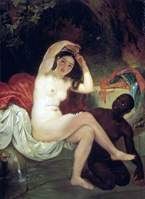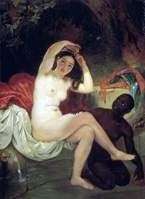
This picture Bryullov wrote about three years, but never finished. However, the carefully designed sketch looks like an almost complete picture. In the work on it, the artist used a biblical story telling how King David, who was walking around the palace in the evening, saw the naked Bathsheba, the wife of his commander, and was struck by her beauty.
They say that Bryullov, unsatisfied with the result of his work, once threw a shoe at Bathsheba and never returned to it again. Poetry and truth Bryullov – one of the frequent examples for the beginning of the XIX century of mixing several national elements into something original and harmonious.
His distant ancestors were French Huguenots, close ones – German-enamored French, the nearest – Russified Germans; Briullov himself continues the unification of Europe – he is fascinated by Italy since childhood. Bryullov surprised contemporaries with some kind of warm humanity and sincere emotion of his paintings; every plot of his was written with a special intonation, was permeated with a unique mood.
In the early 1860s, the ideologist of the new art, critic V. Stasov, began to overthrow the old idols, and the first purpose of his attacks was precisely Bryullov. Everything is clear – new artists were in love with “social” art, and Bryullov’s creativity was interpreted as a betrayal of the truth, a departure from reality. In fact, Bryullov was not very interested in the “social” truth, little interest in politics, the suffering of the people, etc., etc. His whole life was interested in beauty. But is this unworthy interest?
 Bathsheba – Karl Bryullov
Bathsheba – Karl Bryullov Pifferari before the image of the Madonna by Karl Bryullov
Pifferari before the image of the Madonna by Karl Bryullov Paintings of the plafond of St. Isaac’s Cathedral by Karl Bryullov
Paintings of the plafond of St. Isaac’s Cathedral by Karl Bryullov Portrait of AN Demidov of San Donato by Karl Bryullov
Portrait of AN Demidov of San Donato by Karl Bryullov The head of the girl by Karl Bryullov
The head of the girl by Karl Bryullov Hermitage in the Shepherds by Karl Bryullov
Hermitage in the Shepherds by Karl Bryullov Bathsheba – Karl Brullov
Bathsheba – Karl Brullov Vespers by Karl Bryullov
Vespers by Karl Bryullov